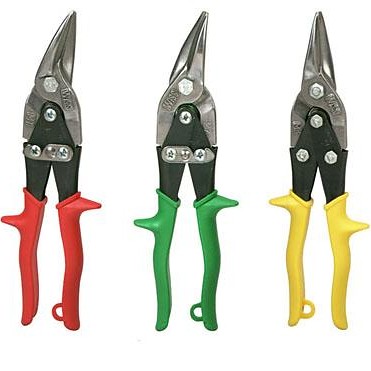We've been doing quite a bit of HVAC work of late as we get ready for the heat of summer and the various items necessary for the master bathroom renovation. From demolition of horrendously installed duct work, to custom fabrication of vent boots, even the most minor work that needs to be performed on ducts requires the right tools.
Over the years I've gotten more and more comfortable with the work we've been doing in our home's ducts. But my comfort with the work we've done has been due in no small part to the correct selection of my set of snips that I purchased years ago.
When we were just starting to work on HVAC I knew I'd need a pair of straight cutting metal snips, so I headed out and picked up a pair of compound action snips with an ergonomic handle. There are many different kids out there, from the snips that look like simple oversized scissors, to ones that are actually pneumatic, but a basic middle of the road compound cutting tool should do just fine for most purposes.
The compound movement of these snips allow them to cut up to 18 gauge metal with relative ease. You don't have to exert a tremendous amount of force to get through the material, and it tends to make a nice clean line. This isn't to say you won't get a good forearm workout if you're cutting a lot of metal during a project.
These straight cutting snips are what I tend to use in probably 75% of situations where I need to cut metal for duct work. They have a small set of blades, allow you to begin cutting from a point, and they make a nice and straight line without damaging either side of the cut. Some snips will leave one side crisp while bending and folding the other side out of the way.
I used these straight cutting snips to make the small cuts in the corners of the duct boot last week. They did just what I needed and left me with a good edge to work with.
As useful as the straight cut snips are, there are often times where you need to make a curved cut. While the straight snips will work on a soft curve to a certain extent, if the bend of the curve gets at all tight you'll end up wrestling more with the snips and the metal than you will end up making progress. That's when the second set of snips comes into play.
After becoming overly frustrated trying to cut a round (not oval or jagged) hole for some 6" round duct many years ago, I learned of the more specialized snips that are made just for this purpose. There are actually two different kinds, one that allows you to make a curve to the right, and one that allows a curve to the left. If you picture a pair of scissors cutting a piece of paper, think about the way the blades actually work to cut the paper, one side forcing the paper up while the other down. With paper, it's easy to cut a curve, because you can easily manipulate the paper, but with metal, you need to be able to manipulate the cutting tools to accommodate the metal, do you need snips that can perform this same function as paper scissors, without the benefit of being able to bend and fold the material you're cutting.
The pair of right cutting snips I bought completely blew my mind. As soon as I started using them I couldn't believe how simple it was to make a nearly perfectly round hole. I'm a lefty when it comes to dexterity work like writing, cutting, and eating, (I'm right handed for most other things) so the right cutting snips that make a clockwise circle work easily for me. The blades are shaped in a way that allows the left upper blade to remain on top of the work, with the right lower blade remaining under the work. As you cut, the blades are able to stay out of the way of the metal you've already cut. It's rather ingenious.
These snips are what I was able to use to cut these perfectly sized 8" holes in the end of the HVAC duct boot, repairing the horrible installation that had been completed 30 years prior.
For good measure I picked up a pair of left turn counterclockwise cutting snips for those situations where the material I'm cutting is fixed and I can't manipulate my body to make the clockwise snips work. Each handle is a different color, green for clockwise, yellow for straight, and red for counterclockwise, so they're easy to identify in the tool bucket and can usually be quickly located when necessary.
I know that three pairs of snips for one seemingly simple task may sound a bit unnecessary, but your hands and your mental stability will thank me when you get to a point where your life becomes just a little bit easier when you use them.
Do you have a favorite pair of metal cutting tools that you like to use in your duct projects? Perhaps you have a good tip, trick, or technique that will help me with my cutting tasks. Let me know what you think.
Did you enjoy reading this post? Want to learn more about our first-hand experiences with other tools, devices or items used throughout our renovation? If so, check out our complete list of product reviews in our Toolbox Tuesday section.
Note: We weren't paid for this review. We simply want to share good products when we see them, and hope that learning from our mistakes can help save you time, money and frustration.

![]()
![]()